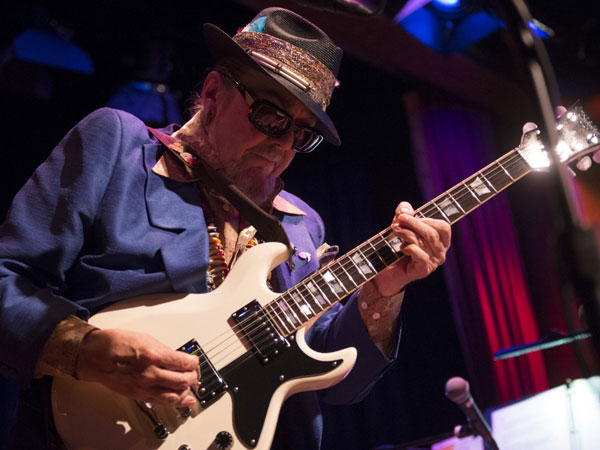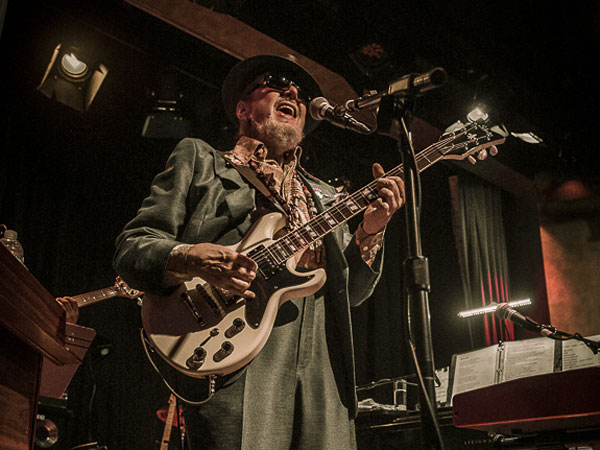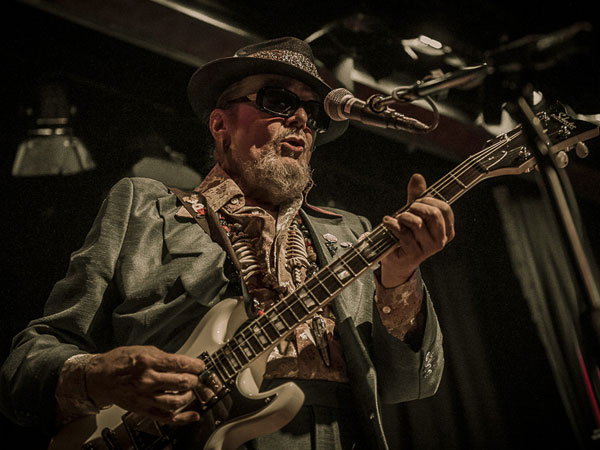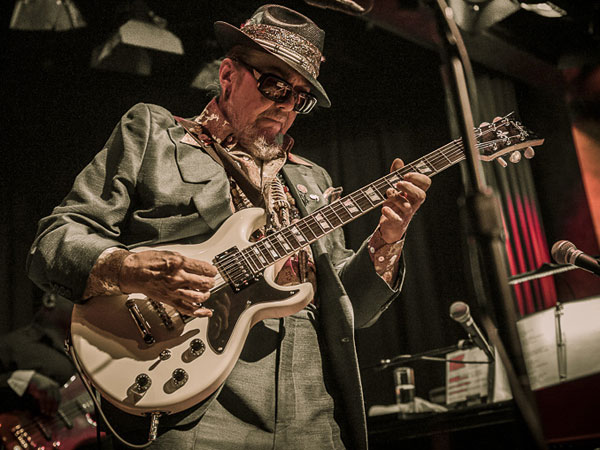Dr John on his love of guitar playing
How a run-in with a gun shaped the Dr's career

Introduction
Dr John's music teacher smashed up his first guitar and a stray bullet nearly ended his six-string career altogether. So why is the fretboard still his first love? We meet the king of voodoo blues to find out...
Since he first burst into the public consciousness with his psychedelic voodoo-dripping debut solo album, Gris-Gris, in 1968, Malcolm John 'Mac' Rebennack (aka Dr John The Nite Tripper) has carved out his own eccentric sub-chapter in the history of American music - and New Orleans-style music, in particular.
"Before nearly losing a finger during an on-tour gunfight, the future Doctor had been a prevalent guitarist on the New Orleans session scene"
His inimitable skills as a piano player are just as recognisable as his gravel-rich voice and necromantic 70s stage garb, but the six-string guitar was Mac's initial career instrument of choice.
Before nearly losing a finger during an on-tour gunfight, the future Doctor had been a prevalent guitarist on the New Orleans session scene and the US's vibrant 1950s Chitlin' gig circuit.
This accident ultimately forced Mac to concentrate more on his keys playing and he went on to become a significant member of LA's Wrecking Crew session scene during the 1960s, before his solo career kicked off in such exuberant style towards the end of that decade.
Earlier this year at Ronnie Scott's, we were lucky enough to witness Dr John's incredible axe skills in person as he strapped on a hired Tele to bang out a suitably soulful string-bending version of Earl King's Mama & Papa. The big man's still got it, that's for sure. And that Dr John guitar album will hopefully just be round the corner...

First love
You're most widely known for your skills on the piano and as a singer and songwriter, but you did a lot of session work as a guitarist back in late-1950s New Orleans. Did you start playing the piano or the guitar first?
"I played the guitar first before I played the piano. My sister played the piano and two of my aunts played the piano. One auntie played for the silent movies in New Orleans.
"Roy Montrell took me to hear flamenco guitars and classical guitars - all kinds of different stuff"
"I know my mother used to love to hear me play the piano, but I only knew this one [piano] song back in the game, The Texas Boogie, and that was something my Uncle Joe and my Aunt Audrey taught me, and that was a blessing... But I was the first one that played guitar in my family."
Did you have guitar lessons?
"Well, I remember I took lessons from Al Guma first and Walter 'Papoose' Nelson second and Roy Montrell third. They were all my guitar teachers. My father knew Al Guma and he recommended that I go learn how to read music from somebody.
"Walter 'Papoose' Nelson was my second guitar teacher and he taught me how to play like T-Bone Walker and a lot of guys that were popular in that day, you know.
"Later, Roy Montrell took me to hear flamenco guitars and classical guitars - all kinds of different stuff that I would've never heard before. My father, back when he sold records, didn't sell records like that.
"This guy, Roy Montrell, brought me to hear a lot of great guitar players at the Loyola Field House back in the game. He knew most of the guys, you know, even if he couldn't speak the same language as them."

Finding the fire
It sounds like you were absorbing a lot of different guitar stylings back then...
"Yeah, I learned a lot of jazz stuff and I learned a lot of different kinds of music from this guy, Roy Montrell, because he not only had played on a lot of jazz records, he had also played on a lot of other things. He played on some really great records.
"I love to hear guys that are really unique, that speak out"
"I remember he taught me how to play Rhapsody In Blue and that's a very difficult song to play on a guitar. Wow, that took me a lot of years to learn, but he used it to con me into taking some more lessons because that was his hustle.
"My friend was taking lessons from him, too, and he said to me, 'This guy's ahead of you and he's playing better than you.' He used all of that to get my head screwed on straight and that was a good thing."
Who were your favourite guitarists when you were growing up?
"There was a guy that Brigitte Bardot discovered but I don't even remember his name now [Dr John is most likely talking about famed French Gypsy flamenco player, Manitas de Plata, a close friend of Bardot's].
"Roy Montrell took me to his concert and sort of told me, 'This guy is gonna make some mistakes but he's got the fire!' and I knew what he meant immediately - that guy was the fire! He played some of the hippest things that I ever heard on a guitar ever. I just thought, 'Wow, this guy's slammin'!' I couldn't think enough about the guy. I just never heard a guitar player play that way.
"I love to hear guys that are really unique, that speak out. I also loved Snooks Eaglin... and there were certain other guys that always stuck out like Johnny Smith, the guy who made Moonlight In Vermont a very popular song. He was special, you know."

Slim pickers
When did you start going on the road with your guitar?
"I had learned enough to win a high school talent show, but they kicked me out of the school because I won the show. I played [The Kinks' ] Hide And Seek and they thought it wasn't cool.
"I never met more guys named Slim than when I was on that first tour"
"I'd got kicked out of three schools and my pa said, 'Kid, you should take that gig on the road with the Chitlin' circuit with them old men' - and that's what I did.
"I never met more guys named Slim than when I was on that tour. I met Guitar Slim, Memphis Slim, Polka Dot Slim, Sunnyland Slim, on and on. I met so many guys named Slim on that tour, I never thought I would stop meeting them. Then all of a sudden, I realised, 'Wow, Slim's an unusual name!'"
How much did you learn from the other players on that circuit?
"Oh, I learned a lot! Elmore James and a lot of great guitar players were on that circuit, and even T-Bone Walker was on that circuit.
"That was special to me. I would try to listen to everybody that I admired and see the way they played. 'Papoose' had taught me to play like T-Bone so I kind of knew his stuff, but I could learn better about his playing from seeing him."
You released a killer rock 'n' roll guitar instrumental, Storm Warning, on Rex Records in 1959 under your own name, Mac Rebennack. What do you remember about that recording?
"Even though it was kind of a weird thing to do... I remember we actually were doing a session at Cosimo [Matassa]'s [J&M] recording studio in New Orleans, and there was a hurricane that went outside of it and we were actually cutting that song.
"It was weird... but Allen Toussaint was playing the piano on it and a lot of great musicians were playing on it. 'Red' Tyler was playing the bari sax and Lee Allen was playing the tenor sax."

Wrecking Crew
In the early 60s, you were involved in a tragic incident in Jacksonville, Florida where you got shot in the finger. What actually happened, and how far did that affect guitar being your main instrument?
"Well, this guy was pistol-whipping the singer of my band and his mother had told me, 'If you let anything happen to my son while he's on the road with you - because he was very underage - I'm gonna cut your cojones off!' And his mother left a picture in my head of her doing that!
"The gun went off and I saw my finger just hanging by a string"
"I was trying to get the gun out of his hand and I had my hand over the barrel, not over the handle, and it went off and I saw my finger just hanging by a string. I got put in jail because we was in Florida and this guy was a bookie guy... and that was how life went back in them days.
"It shortened my days down as a guitarist, but I still got some work. Gretsch gave me a guitar and I started endorsing Fender guitars, but I couldn't really play it good, so I concentrated more on piano."
After moving to LA, you became part of the famous Wrecking Crew. Were you solely contributing piano to recordings, or were you still also playing some guitar?
"When I was in California, I had no idea the band was called The Wrecking Crew. I was really trying to be the best kind of versatile musician I could be in them days.
"You know, when you're working sessions with Barney Kessel and Howard Roberts and Don Peake, you've got to be taking care of business. There were so many guitar players I played sessions with.
"At the time, I was playing piano, I was playing a guitar and a bass... and three guitar players were playing the same instruments. That was how we got a lot of sessions, you know."

Back catalogue
How much guitar did you play on the first two Dr John albums, Gris-Gris (1968) and Babylon (1969)?
"I remember I got a great guitar player that also played mandolin on the sessions, and I had another guitar player just playing some rhythm stuff, but I was playing another guitar.
"If you're gonna jive around with the guitar, it ain't the thing to do!"
"I probably played [guitar] on most of the tracks on Gris-Gris and Babylon. Then 'Didymus' Washington was the congo player with the band back then. Him and John Boudreaux played phenomenally hip drums and percussion on those records. That was a long time ago, but they're still my favourite drummer and percussionist."
The Meters backed you on two albums, 1973's In The Right Place and 1974's Desitively Bonnaroo. What made you approach them, and what do you think of Leo Nocentelli as a guitarist?
"Well, they were like the hippest band in New Orleans. I loved those guys and I used to go and see them on the gigs when I was in town, you know. They were special... and oh man, I think [Leo] was badass! There was nobody like him in the history of guitar that could have played like he did. He always had a volume manoeuvre, and that was something else with him."
Dan Auerbach of The Black Keys produced and played guitar on your 2012 long player, Locked Down. What was it like playing and working with him?
"Oh, he's cool. I like that album and I think the world of him as a guitarist. I just did some sessions with him recently. But, right now, I don't have a clue in the world what's gonna happen with them [sessions]. Whatever it's gonna be, it's gonna be."
Lastly, is there any guitar advice you'd like to give to the readers of the magazine?
"Hey, listen... you know what? If you're gonna play the guitar, play your ass off! And if you're gonna jive around with the guitar, it ain't the thing to do!"
Visit www.nitetripper.com for more information on Dr John.

